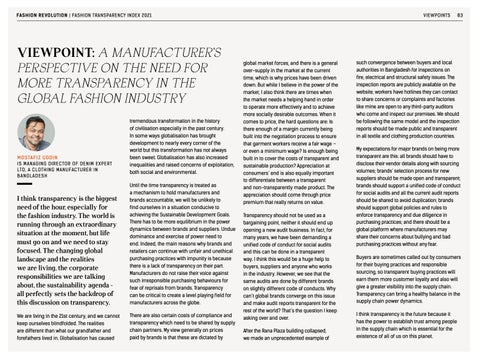FASHION REVOLUTION | FASHION TRANSPARENCY INDEX 2021
VIEWPOINT: A MANUFACTURER’S PERSPECTIVE ON THE NEED FOR MORE TRANSPARENCY IN THE GLOBAL FASHION INDUSTRY
MOSTAFIZ UDDIN IS MANAGING DIRECTOR OF DENIM EXPERT LTD, A CLOTHING MANUFACTURER IN BANGLADESH
tremendous transformation in the history of civilisation especially in the past century. In some ways globalisation has brought development to nearly every corner of the world but this transformation has not always been sweet. Globalisation has also increased inequalities and raised concerns of exploitation, both social and environmental.
I think transparency is the biggest need of the hour, especially for the fashion industry. The world is running through an extraordinary situation at the moment, but life must go on and we need to stay focused. The changing global landscape and the realities we are living, the corporate responsibilities we are talking about, the sustainability agenda all perfectly sets the backdrop of this discussion on transparency.
Until the time transparency is treated as a mechanism to hold manufacturers and brands accountable, we will be unlikely to find ourselves in a situation conducive to achieving the Sustainable Development Goals. There has to be more equilibrium in the power dynamics between brands and suppliers. Undue dominance and exercise of power need to end. Indeed, the main reasons why brands and retailers can continue with unfair and unethical purchasing practices with impunity is because there is a lack of transparency on their part. Manufacturers do not raise their voice against such irresponsible purchasing behaviours for fear of reprisals from brands. Transparency can be critical to create a level playing field for manufacturers across the globe.
We are living in the 21st century, and we cannot keep ourselves blindfolded. The realities are different than what our grandfather and forefathers lived in. Globalisation has caused
There are also certain costs of compliance and transparency which need to be shared by supply chain partners. My view generally on prices paid by brands is that these are dictated by
VIEWPOINTS
global market forces, and there is a general over-supply in the market at the current time, which is why prices have been driven down. But while I believe in the power of the market, I also think there are times when the market needs a helping hand in order to operate more effectively and to achieve more socially desirable outcomes. When it comes to price, the hard questions are: Is there enough of a margin currently being built into the negotiation process to ensure that garment workers receive a fair wage – or even a minimum wage? Is enough being built in to cover the costs of transparent and sustainable production? Appreciation at consumers’ end is also equally important to differentiate between a transparent and non-transparently made product. The appreciation should come through price premium that really returns on value. Transparency should not be used as a bargaining point, neither it should end up opening a new audit business. In fact, for many years, we have been demanding a unified code of conduct for social audits and this can be done in a transparent way. I think this would be a huge help to buyers, suppliers and anyone who works in the industry. However, we see that the same audits are done by different brands on slightly different code of conducts. Why can’t global brands converge on this issue and make audit reports transparent for the rest of the world? That’s the question I keep asking over and over. After the Rana Plaza building collapsed, we made an unprecedented example of
83
such convergence between buyers and local authorities in Bangladesh for inspections on fire, electrical and structural safety issues. The inspection reports are publicly available on the website, workers have hotlines they can contact to share concerns or complaints and factories like mine are open to any third-party auditors who come and inspect our premises. We should be following the same model and the inspection reports should be made public and transparent in all textile and clothing production countries. My expectations for major brands on being more transparent are this: all brands should have to disclose their vendor details along with sourcing volumes; brands’ selection process for new suppliers should be made open and transparent; brands should support a unified code of conduct for social audits and all the current audit reports should be shared to avoid duplication; brands should support global policies and rules to enforce transparency and due diligence in purchasing practices; and there should be a global platform where manufacturers may share their concerns about bullying and bad purchasing practices without any fear. Buyers are sometimes called out by consumers for their buying practices and responsible sourcing, so transparent buying practices will earn them more customer loyalty and also will give a greater visibility into the supply chain. Transparency can bring a healthy balance in the supply chain power dynamics. I think transparency is the future because it has the power to establish trust among people in the supply chain which is essential for the existence of all of us on this planet.
